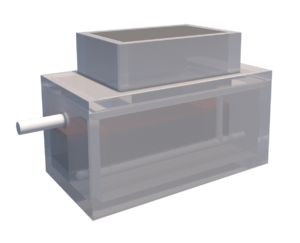When it comes to underground handhole vaults, selecting the right material is crucial. These vaults are essential for protecting critical infrastructure like electrical, telecommunications, and utility systems. The choice between polymer concrete and traditional materials (such as concrete or fiberglass) depends on factors like durability, cost, installation, and environmental impact. This guide will compare these materials to help you make an informed decision.

What Are Underground Handhole Vaults?
Underground handhole vaults are enclosures designed to house and protect utility cables, splices, and other components. They are frequently used in applications like telecommunications, power distribution, and fiber optics. These vaults must withstand various environmental stressors, including moisture, soil pressure, and temperature fluctuations.
Now, let’s break down the key differences between polymer concrete and traditional materials commonly used for these vaults.
Advantages and Disadvantages of Polymer Concrete Vaults
Advantages of Polymer Concrete
- Exceptional Durability
Polymer concrete is made by combining aggregates with polymer resins. This mixture creates a highly durable material that resists cracking, corrosion, and chemical exposure. It is especially well-suited for environments prone to heavy loads, extreme weather, or corrosive agents like salt or chemicals.
- Lightweight Design
Despite its strength, polymer concrete is relatively lightweight compared to traditional concrete. This makes it easier to transport and install, potentially reducing labor costs.
- Superior Weather Resistance
Unlike traditional concrete, polymer concrete does not absorb water. This eliminates the risk of freezing and thawing damage, which is a common issue in colder climates.
- Low Maintenance
Polymer concrete vaults require minimal maintenance. Their durability means they can last decades without repairs, reducing long-term ownership costs.
Disadvantages of Polymer Concrete
- Higher Initial Cost
Polymer concrete is generally more expensive to produce than traditional materials. This can be a drawback for projects with tight budgets.
- Limited Availability
Depending on your location, polymer concrete products might be less readily available than traditional options, potentially leading to longer lead times.
- Brittleness
While strong under compression, polymer concrete can be brittle, making it vulnerable to impact damage during transport or installation if not handled with care.
Advantages and Disadvantages of Traditional Vault Materials
Traditional vault materials include standard concrete, reinforced concrete, and fiberglass. Each has specific benefits but also certain limitations.
Advantages of Traditional Concrete
- Cost-Effective
Concrete is one of the most affordable construction materials, making it a popular choice for large-scale projects.
- Widely Available
Concrete handhole vaults are easily sourced across most regions, ensuring faster access and shorter project timelines.
- Good Compressive Strength
Reinforced concrete, in particular, offers excellent compressive strength, making it suitable for applications with heavy loads.
- Resistance to Fire
Unlike polymer-based materials, concrete is noncombustible and highly resistant to fire, adding a layer of safety for certain applications.
Disadvantages of Traditional Concrete
- Heavy and Difficult to Handle
Traditional concrete is much heavier than polymer concrete, increasing transportation costs and requiring heavy equipment for installation. This can significantly add to overall project costs.
- Prone to Cracking and Corrosion
Over time, concrete can crack due to soil pressure, moisture infiltration, or temperature fluctuations. It is also susceptible to corrosion when exposed to saltwater or industrial chemicals.
- High Maintenance Requirements
Repairs for cracks or weather-related damage can add to long-term expenses, especially in environments with extreme conditions.
- Environmental Impact
The production of concrete is associated with high carbon emissions, contributing to environmental concerns. Additionally, its water absorption properties can lead to inefficiencies in wet environments.
Advantages of Fiberglass
For completeness, fiberglass is another material worth mentioning. Fiberglass vaults are lightweight, resistant to corrosion, and relatively durable. However, they tend to be more expensive than both concrete and polymer concrete, and certain environmental factors like high UV exposure can gradually degrade their performance.
Key Comparison Factors
To make the best decision for your project, consider the following factors:
1. Durability
-
- Winner: Polymer Concrete
With its resistance to cracking, weather, and chemicals, polymer concrete outperforms traditional options in durability.
2. Cost
-
- Winner: Traditional Materials
While polymer concrete offers long-term savings, traditional concrete’s lower initial price can be appealing for budget-sensitive projects.
3. Ease of Installation
-
- Winner: Polymer Concrete
Its lightweight design makes polymer concrete easier and quicker to install, reducing labor expenses.
4. Environmental Impact
-
- Winner: Polymer Concrete
Polymer concrete’s longer lifespan and maintenance-free design mitigate its environmental footprint, while traditional concrete’s production process has a higher carbon impact.
5. Longevity
-
- Winner: Polymer Concrete
Over decades, polymer concrete is less likely to need repairs or replacement, making it the superior choice for long-term projects.
Which Material Is Right for Your Project?
The choice between polymer concrete and traditional materials largely depends on your project’s priorities:
- Select Polymer Concrete If:
You need a highly durable, lightweight, and low-maintenance solution, and you’re willing to invest in higher upfront costs for long-term savings.
- Select Traditional Concrete If:
Budget constraints are paramount, and your project is in a less demanding environment where durability and maintenance are less critical.
- Consider Fiberglass If:
Lightweight materials are a must, but you have the budget to accommodate the higher cost and environmental conditions are stable.
Final Thoughts
Both polymer concrete and traditional vault materials have their strengths and weaknesses. By carefully weighing factors like durability, cost, and environmental impact, you can make an informed choice that suits your project’s specific requirements. Ultimately, investing in a high-quality material such as polymer concrete may provide greater long-term benefits, especially for demanding or high-risk environments.
